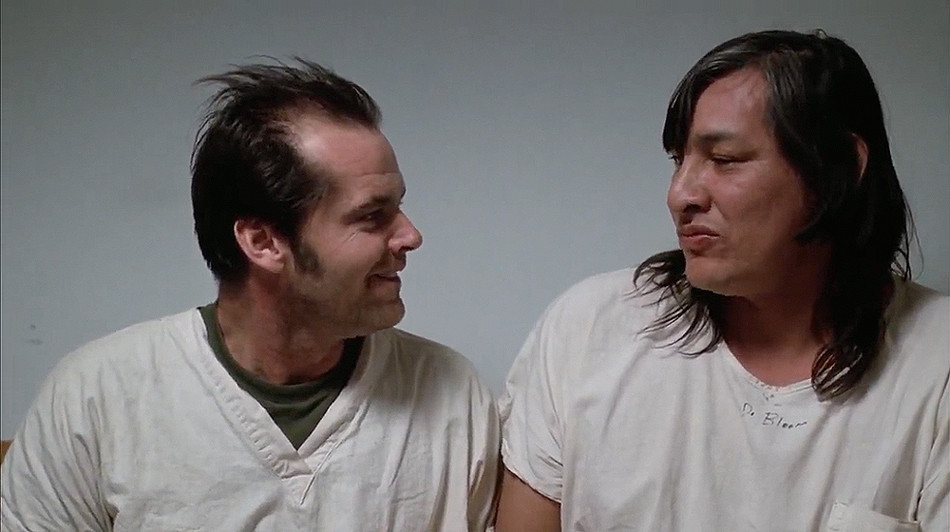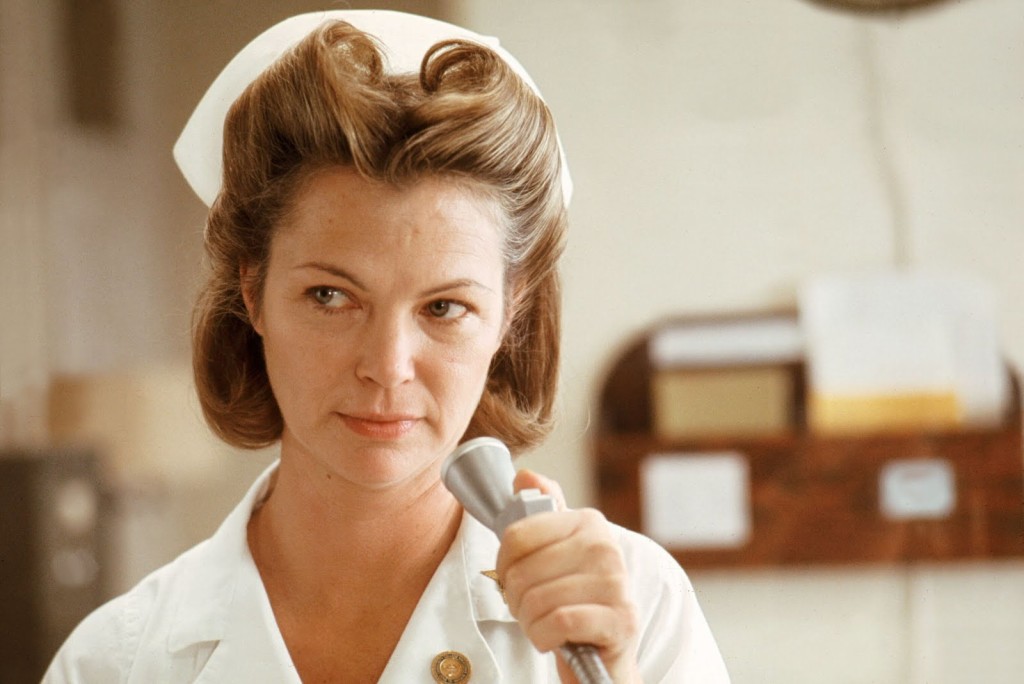Many people believe that the 70s was the second Golden Era of film, but whether the decade created amazing cinema or not, the reality is there are a lot more forms of entertainment these days, the movie-going demographic has changed, and we’ve been programmed to have shorter attention spans. So no matter how you look at it, the way we tell stories in the medium is different than it used to be. Which makes me nervous about propping up a 70s film to learn screenwriting. With that said, a good story is a good story, and I’m certain that this script would get made today (who would play McMurphy though??). It has that “No. 1 Black List Spot” feel to it. Its secret ingredient is its characters. The film has one of the best collections of characters in history. For those who haven’t seen it, “Nest” is about a convict, McMurphy (Jack Nicholson), who tries to play the system by pretending to be crazy, believing it’ll be a lot easier to do his time in a mental facility than in prison. Once there, he rouses the other patients into action, helping them realize that even if they’re crazy, they can still have fun. But when the floor manager, the deceptively evil Nurse Ratched (one of the best villains ever), sees that she’s losing a hold on the patients because of McMurphy, she finds a horrifying way to solve the problem. One Flew Over The Cuckoo’s Nest won an Oscar for Best Adapted Screenplay.
1) Starting as late into the story as possible – Yesterday we discussed how you want to start your script AS CLOSE TO the main action as possible. Here’s an example of that in action. In the script for “Cuckoo’s Nest,” we start off with McMurphy at prison, showing him causing trouble. Only then does he get sent off to the ward. In the movie, we don’t show that. We just show McMurphy showing up to the mental ward. It was a good decision. Why do you need to show McMurphy causing trouble at a prison when you can just show him causing trouble as soon as he gets to the mental ward? Additionally, we get to jump right into the story.
2) The “Institution Disruption” Flick – They used to do a lot more of these films (Cuckoo’s Nest, Cool Hand Luke, K-Pax, Shawshank) but you don’t see them as often these days. And I’m not sure why. They’re an excellent set-up for a story. You have an institution (prison, mental ward, school, army) that’s running smoothly, then you bring in a dangerous character who upsets the balance of the group. Conflict is built into the premise, since the establishment will want to regain control over the disrupting individual, which means that a lot of the scenes will write themselves (I’ve found that when you introduce natural conflict into a story, scenes write themselves).
3) How to name a villain – This is well-known device, but I’ll repeat it here anyway. To name your villain, find a negative and/or scary word, then move a few letters around until you get something that sounds similar. “Hatchet” is the operative word here, of course. The writers turned that into Nurse “Ratched.”
4) Ironic villains are typically the best villains – Nurse Ratched is one of the best villains in the history of cinema. But is it because she’s an outward bitch? Because she’s always mean? No. Nurse Ratched is actually quite logical. She’s also calm, and she genuinely wants to help everyone. Her motivation is noble. Had Nurse Ratched had a “Wicked Witch of the West” scowl the second we met her, the character would’ve been infinitely less interesting. This is yet another example of writing villains the OPPOSITE of what you’d expect a villain to be.
5) The dialogue before the storm – One of the things a lot of screenwriting books tell you to do (and I’ve said this too) is to start as late into a scene as possible. For example, if two partners are meeting to talk about their failing business, you’d cut to them in an office with the first line being, “How did we get here?” The thing is, you don’t always want to do that. If you do, your script will start to feel rigid and lifeless. Instead, write in some “dialogue before the storm” to give the illusion of “real” conversation. So when McMurphy is called in to the President’s office to discuss why he’s here at the ward, we don’t start with, “Why don’t you tell me why you’re here, Mr. McMurphy.” We start with McMurphy noticing a fishing photo on the president’s desk and asking him about it. It’s a slightly awkward conversation, since the president wasn’t prepared to talk about the photo, but more importantly, it felt natural. I wouldn’t use this approach in every scene. But you should do it every now and then to create the illusion of reality.
6) Give us one scene that encapsulates the world the protagonist is now in – In the “Institution Disruption” flick, it’s vital that you write a scene that shows the audience exactly what kind of world we’re in. One of the first scenes in “Cuckoo’s Nest” is McMurphy taking part in his first “Group Therapy” session. In it, one of the characters starts yelling at another. Another one quickly breaks down. Another one starts rocking back and forth. Everybody else takes sides, until everyone’s either screaming or yelling or arguing or rocking or making noises. McMurphy looks around at all this chaos. It’s at that moment that we know exactly what kind of world we’re in.
7) Mid-point shift – Remember that the mid-point shift is the moment in your script (roughly the middle of the movie) where something happens that SHIFTS the story in a slightly different direction. Without it, your script will start to feel redundant. The mid-point shift in “Cuckoo’s Nest” happens subtly, when McMurhpy brags to one of the guards that he’s getting out in two months. The guard corrects him. His prison sentence may have had two months left on it. But here at the mental ward, they can keep you… forever. McMurphy’s world is rocked. He had no idea that was the case. Now his “goal” shifts from “act crazy” to “escape.”
8) How to build characters in an ensemble – When you have a bunch of characters in a group, you don’t have time to explore them all. But each of them must still be memorable. To achieve this, give each of them ONE DOMINANT MEMORABLE TRAIT and then keep hitting on that trait throughout the script. One of the patients believes he’s smarter than everyone and looks down on the other patients as a result. Another is the “village idiot” who just smiles all the time. Another just wants everybody to get along. Another has zero self-confidence and is afraid to speak up. When you don’t find that trait, the character will disappear. Christopher Lloyd is actually in “Cuckoo’s Nest,” but you don’t remember him because they didn’t give him a specific trait. You can find this approach in Cuckoo’s Nest, Toy Story, Cool Hand Luke, Shawshank and many other films.
9) The anti-hero method for saving the cat – Anti-heroes shouldn’t save the cat like traditional heroes. Their saving should be a little more complicated. In fact, they might even kick the cat a few times before saving it. If you write them doing something overly nice in a way that’s completely out of character, the story will ring false and the audience will turn on you. The “Save the Cat” moment in Cuckoo’s Nest is when McMurphy tries to befriend the deaf and dumb giant, “Chief.” It’s his support of the character when nobody else supports him, that earns him our sympathy. The amateur writer probably would’ve written this scene with somebody bullying Chief, and McMurphy stepping in to save him. FORCED! Instead, what does McMurphy do? He makes fun of Chief! He does an offensive “How” impression of an Indian. Then does an even more offensive Indian dance to get him to react. It isn’t until later, when he teaches Chief to play basketball, that he starts to help him.
10) Writing a friendship into a story – There’s something about writing a friendship into a story that is so powerful if done right. From McMurhpy and Chief here, to Ratso and Joe Buck in Midnight Cowboy, to Red and Andy in Shawshank, to Vasquez and Drake in Aliens. When you do this, for whatever reason, it makes us like the characters twice as much. You guys are welcome to hypothesize on why this is, but all I know is that watching Chief and McMurhpy become friends made me like each of them that much more.



